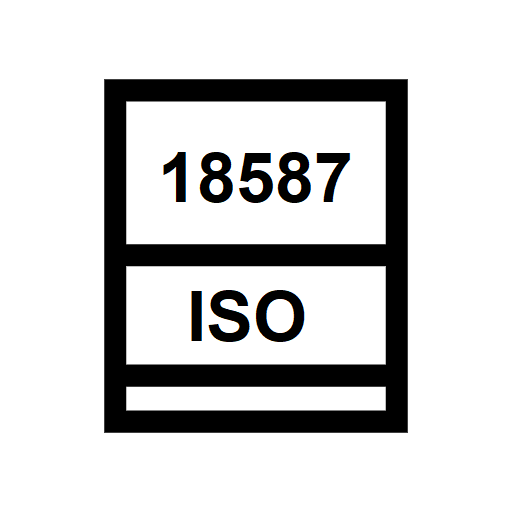ISO 18587
Machine translation service with full human post-editing

International standard ISO 18587 establishes the requirements to ensure that, after post-editing of the output of a machine translation, the quality is similar to that of a human translation.
To this end, the ISO 18587 quality standard describes in detail:
- The objectives in the post-editing process,
- The requirements for full post-editing of the output of a machine translation (MT),
- The post-editor’s tasks,
- The competences and qualifications of post-editors.
Below, we will explain in detail all the subsections of the ISO 18587 quality standard. Translation services. Post-editing the output of a machine translation. Requirements.
Definition of machine translation and post-editing
1. What is a machine translation system?
A machine translation system is a computer program that automatically translates a text from one language to another using artificial intelligence without human intervention. Currently, neural machine translation systems are used to produce more accurate and natural results than previous rule-based systems. DeepL, Google or Yandex are some of the current neural machine translation systems.
2. What is post-editing and what kinds of post-editing are there?
Despite having improved a lot in recent years, machine translation systems are not perfect. Post-editing is the process of improving the output of a machine translation. There is light post-editing that is limited to correcting the most serious errors and generating a sufficiently comprehensible text. On the other hand, the aim of the full post-editing process, which is what the ISO 18587 standard covers, is to obtain an output similar to that of a human translation. The person that carries out the post-editing is called a post-editor.

Post-editing process according to ISO 18587
As we have just indicated, the post-editing process consists of modifying and correcting the output of a machine translation. The scope of the ISO 18587 standard is limited to full human post-editing, where a quality similar to that of human translation is achieved. Next, we will explain the pre-production processes (feasibility, pre-editing, quotation), production (full post-editing) and post-production (final verification) outlined in ISO 18587:
Pre-production process
(feasibility, pre-editing, quotation)
Feasibility analysis of machine translation projects + full post-editing.
This phase examines whether it is feasible to use machine translation and post-editing for a specific assignment and whether it is appropriate to prepare the source document (pre-editing) before using machine translation.
Can machine translation and post-editing be used with any document?
Any translation company certified according to the ISO 18587 standard has a process for evaluating the feasibility of the combined use of machine translation and post-editing. To begin with, we can affirm that it cannot be used with all types of texts.
When is it advisable to hire this ISO 18587 translation service?
It is recommended to use translation services in line with ISO 18587 when dealing with short deadlines, limited budgets or large volume translations with repetitive content and an extensive translation memory available. A translation memory is a database of bilingual phrases translated by a professional translator.
Another key factor when opting for this translation service is the syntactic, lexical and morphological similarity between the source and target languages. It is also advisable to have a terminology glossary approved by the client and reference material.
Is it necessary to prepare documents before submitting them to the machine translation system?
An ideal document for processing in a machine translation + post-editing system meets the following requirements:
- it is well-written,
- it uses simple phrases,
- it does not use convoluted or ambiguous syntactic structures,
- it is coherent from a terminological point of view,
- it contains repetitive text,
- it does not use excessive synonyms.
When the majority of the previous requirements are not met, pre-editing of the document is recommended, that is to say, modification of the text to improve the output of the machine translation and to facilitate the work of the post-editor. The pre-editing phase is always advised when the document is going to be translated into several languages.
After confirming that the project is viable, the translation agency certified according to ISO 18587 sends a quotation to the client. When the client accepts and the agreement has been formalized, the order is recorded in the quality system and moves on to the production phase.

Production process
(full post-editing requirements and post-editor's tasks)
Human post-editing of machine translation outputs takes place in a multimodal environment with computer-aided translation tools (CAT Tools), like SDL Trados or memoQ, a machine translation system, like DeepL or Google Translate, translation memories, terminology glossaries, etc.
This section of the standard explains the aims in the post-editing process, the post-editor’s tasks and the requirements for full post-editing.
Post-editor's tasks
The post-editor is a professional translator with experience in correcting machine translations. The task of a post-editor in a full post-edit is to read the machine translation and to modify it so that the quality of the translation is identical to a human translation. To do this, the post-editor will decide whether to reformulate the content of the machine translation, provide a new translation, etc.
Requirements for full human post-editing of machine translation output
The ISO 18587 certified translation service provider must ensure compliance with the requirements indicated in the standard:
- They must follow the terminology glossaries approved by the client, the reference materials, the terminology of the documents’ area of specialisation and ensure terminological consistency;
- All spelling, syntax and punctuation conventions of the target language must be respected, and the style guide and local conventions must be respected;
- The final document should be delivered in the same format as the original;
- All applicable standards must be complied with;
- They must ensure that the final document is suitable for the intended audience;
- The post-editing guidelines and any other agreements reached with the client must be complied with.

Post-production process
(final verification, delivery and feedback)
The result after full post-editing is comparable to that of a human translation. An ISO 18587 certified company must perform several quality checks and verify the final document as agreed with the customer before final delivery.
Also, the standard specifies that post-editors must have the possibility of making comments on the performance of the machine translation systems and recurrent errors in the MT output, in order to improve the system and the process.

Full post-editing requirements according to ISO 18587
The ISO 18587 standard specifies that the aim of full post-editing of a machine translation is that “the output is indistinguishable from human translation output”. To do this, post-editors should focus on the following aspects:

- Ensure that no information has been added or omitted;
- Correct inadequate content;
- Rephrase sentences if the meaning is unclear or incorrect;
- Create accurate content in the post-edited document, taking into consideration grammatical, syntactical and semantic aspects;
- Follow the terminology of the client or area of specialisation;
- Apply spelling, punctuation and syllable separation rules;
- Ensure that the style is appropriate for the type of document and that the style guidelines provided by the client are followed;
- Respect formatting rules.
Competences and qualifications of post-editors

ISO 18587 encourages certified companies to ensure that post-editors have the specified competencies, qualifications and professionalism.
Post-editor competencies
Post-editors are professional translators. The ISO 18587 standard requires the same competencies from post-editors as the ISO 17100 standard (Certified Translation Service) does from professional translators.
The six competences are: translation competence, linguistic and textual competence in the source and target languages, competence in research, information acquisition and processing, cultural competence, technical competence and domain competence.
Qualifications of post-editors
As is the case with translators in the ISO 17100 standard, the criteria to accredit post-editors according to ISO 18587 are the following.
They must present documented evidence that they meet one of these three criteria:
- A degree in translation, linguistics or language studies, or an equivalent higher degree with specific training in translation;
- A higher university degree in another field and two years as a full-time translator or professional post-editor;
- Five years of full-time experience as a translator or post-editor.
Professionalism of post-editors
Another of the ISO 18587 standard requirements is that post-editors employ a professional method in post-editing tasks and it specifies that post-editors must:
- Be familiar with the technology of machine translation systems and the common errors of these systems;
- Be familiar with computer-aided translation tools, such as SDL Trados or memoQ;
- Be able to evaluate the time and effort required to edit a machine translation and to determine whether or not the task is worthwhile;
- Be able to follow the instructions and guidelines provided and correct and modify as necessary so that the result is similar to that of a human translation.